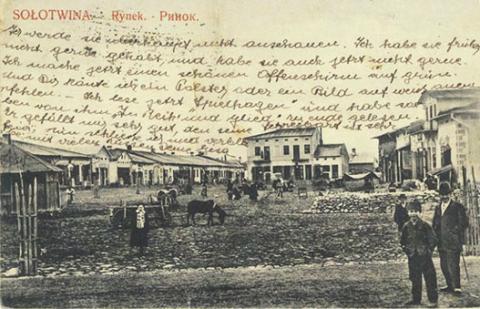
(Solotwino, the Market square. Postcard, 1907)
The story of Jewish Solotvin is the story of an eastern Galician shtetl, a small rural community with unique cultural characteristics and a vibrant intellectual and spiritual life.
The history of Solotvin is intertwined with the major phenomena of moderan Jewish history, such as Hassidism, modernity, Enlightenment, tradition and secularism, nationalism and Zionism, anti-Semitism, etc.
Solotvin (Solotwina) was established in the second half of the seventeenth century as an estate of a local gentleman. At that time, it was also known as Krasnopola. In 1865 there were 210 houses in the town.
Documentary evidence of a Jewish presence in the town dates back to 1717, when local Jews paid a tax of 387 zloty (Pinkas Kehilot, 350). The Polish census of 1764 gives the following information regarding the Jewish population of Solotvin (Stampfer, 121): the community included 471 Jews of both genders and 19 infants less than one year of age. 361 Jews and 15 infants lived in Solotvin itself, with the remaining 110 people residing in the town environs.
Jews lived mainly in the center of the town and suffered greatly from the fire of 1888, in which some 600 houses were burnt down. In spite of this fire, the Jewish population grew and reached its peak population at the beginning of the 20th century. In 1900 there were 1948 Jews living in Solotvin (about 50% of its total population).
The Russian occupation during World War I in 1914-1915 was harmful to the Jewish community. As a result, almost all of the Jewish homes destroyed, much property was stolen, and several Jews were killed by Russian soldiers. More than two-thirds of the town’s inhabitants left Solotvin.

(Ruined street in Solotwino. Photo from WWI)

From a flourishing town that had existed up to World War I (in which the Jews made their living from trade and commerce), Solotvin became an impoverished town between the two wars, and its Jews were supported by the Joint and by their relatives abroad.
Between the two wars, the situation of the Jews of Solotwina in terms of personal safety worsened. The Jews who went between the towns of the area selling their goods were in danger of their life. In 1924 a shoemaker and his wife were murdered in a village close to Solotvin when they came to demand their fees for repairing their work from a farmer. In 1937 riots broke out against the Jews, with their pretext being was a personal conflict between a Jewish salesman and a country customer. Only after police intervention did the riots stop.
We have no information on the fate of the Jewish community of Solotvin during the Second World War, except for the partial information that the settlement was destroyed by the Nazis. In 1942 the Jews of Solotvin were sent to Stanislavov, to a camp called "Rudolph's Mill", where they were killed or sent on to the Belzec extermination camp. (Pinkas Kehilot, 350)
Only two Jews remained in Solotvin after World War II.
Already in 1946 the local authorities wished to liquidate the Jewish cemetery, but they were stopped by the Council on the Matters of the Religious Cults (see document).
The synagogue (1, Kotliarevskogo St.) and the large Jewish cemetery of Solotvin are preserved. The synagogue was documented by the Center of Jewish Art at the Hebrew University of Jerusalem. The cemetery was partially document by the Center of Jewish Art in 1999; full documentation was performed by the Field School in August 2009 and can be viewed here.
On 16 October 2005 a monument to Holocaust victims was erected in Solotvin (link).
Population
| Year | General Population | Jewish Population |
|---|---|---|
| 1880 | 3,117 | 1,541 |
| 1900 | 3,814 | 1,948 |
| 1921 | 2,136 | 620 |




